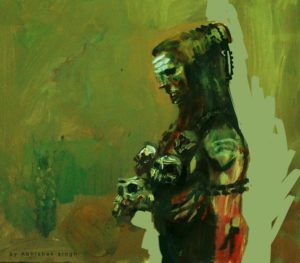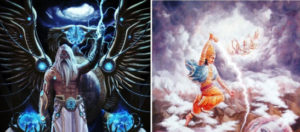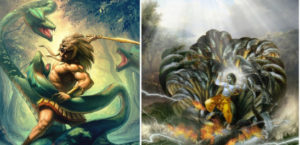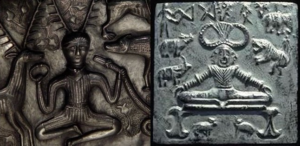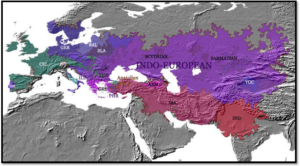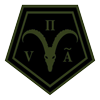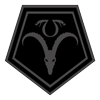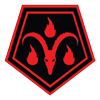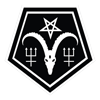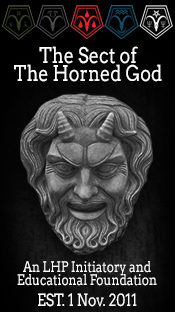Common Roots on the Left-Hand Path
By Thomas LeRoy
“The East/West division dissolves when an understanding is gained concerning the common traditional roots of both branches, which lie in the substrata of Indo-European philosophies. Furthermore, the entirely cross-cultural nature of the left-hand path will become more obvious.”
~ Stephen E. Flowers, Ph.D.
The fifth order in The Sect of the Horned God is called “The Order of Shiva”, and because of this we have been asked as to why we incorporate Eastern Left-Hand Path traditions into our philosophy. Truth be told, the East and West are not as different as you may think based upon the existence of similarities amongst the deities, religious practices and mythologies of the Indo-European peoples. Proto-Indo-Europeans (PIE), the people who gave birth to these common traditions, had a pantheon of gods with similar names and attributes as the gods we are more familiar with. Dyēus Phtēr, for example, was their god of the day-lit sky and the chief god of the Indo-European pantheon. The name survives in Greek with Zeus and the vocative form “Zeu pater”; Latin “Jupiter”.
Consequently, the different branches of Indo-Europeans religions (Greco-Roman, Germanic, and Celtic in Europe, and Hindu, Persian, etc. in Asia), have many similarities:
Zeus and Indra — Not only are they both the “King of the Gods” in their respective mythologies, but their weapons of choice (the lightning-bolt) are the same. In spite of being immortals they resemble human beings for they both show emotions of love, jealousy and anger. Both succumbed to the charms of pious mortal women and impersonated their husbands to seduce them and both of them have many wives.
Hercules and Krishna — Hercules tale of the killing of the Stymphalian Birds, and Lord Krishna killing Bakasura, the bird demon. Hercules capturing the Cretan Bull, and Lord Krishna slaying Arishtasura, the bull demon. Hercules rounding up the horses of Diomedes, and Lord Krishna battling against Keshi, the horse demon.
Cernunnos and Pashupati — The most well known depictions of these two gods, one Celtic the other proto-Indian, shows them horned, seated in a lotus position and surrounded by animals. Pashupati is a “proto-Shiva”, Shiva the Destroyer, the god of the left-hand path in the Hindu tradition.
Even the Celtic Druids and Hindu Brahmins share many similar traits. The Druids, for example, were not simply a priesthood, but were the intellectual caste of ancient Celtic society, incorporating judges, lawyers, medical doctors, ambassadors, historians and so forth, not unlike India’s Brahmin caste. Also, the Druid’s relationship with the tribal king, or ri, was very similar to that of the Brahmin and the raja. On a deeper metaphysical level, they also shared the idea of rebirth and the transmigration of the soul.
“The very name Druid is composed of two Celtic word roots which have parallels in Sanskrit. Indeed, the root vid for knowledge, which also emerges in the Sanskrit word Veda, demonstrates the similarity. The Celtic root dru which means ‘immersion’ also appears in Sanskrit. So a Druid was one ‘immersed in knowledge’.”
~ Peter Beresford-Ellis
Turns out there are many similarities between Old Irish (Celtic) and Sanskrit:
Old Irish – aire (freeman),Sanskrit – arya (noble)
Old Irish – noeb (good), Sanskrit – naib (holy)
Old Irish – bodar (deaf), Sanskrit – badhirah (deaf)
Old Irish – nemed (sacred/privileged), Sanskrit – names (respect)
It has been hypothesized that the spiritual traditions of both East and West are based upon the ancient Indo-European philosophy of “The Eternal Natural Law” (also known as “The Perennial Philosophy”), which emphasizes the aspect that both you and the Divine are one. The Asatru, or Odinists, call it “Örlögr”. In Egypt it was “Ma’at”. In Avestan Persian, “Asha”, and in Sanskrit it is called “Sanatana Dharma”. But in the West the Eternal Natural Law was forced into extinction by the Abrahamic faiths, namely Christianity and Islam, whose dogmas preach that one must seek salvation through subservience to the Divine. And much of what we know of The Eternal Natural Law (which in the West had eventually become known as Witchcraft), is filtered through a warped Abrahamic misunderstanding (examples would be The Malleus Maleficarum, or Compendium Maleficarum, books that set forth much of the modern misconceptions). Many throughout the Western World, though, have attempted to revitalize the old ways. But, whether they realize it or not, it is often based upon the bastardized Christian interpretations. This can obviously be seen in Wicca and other forms of modern paganism, while other revisionists have simply resorted to guesswork and faith. Examples of which would be those attempting to resurrect the Greco/Roman traditions, or the Modern Druids.
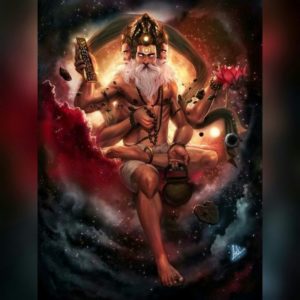
In the East, though, that tradition has remained unbroken for over 5,000 years. The Abrahamic influence did not supplant Sanatana Dharma. Throughout history the Islamists attempted to bring about its demise, but the old ways prevailed. There it need not be resurrected for it never died. In the West, though, there is a chasm separating modernity from the Eternal Natural Law. It is a wide expanse where we see only tiny, distant images on the far side. But there is a bridge across that chasm, secure and steady, and that bridge is Sanatana Dharma.
“An approach via the East will disentangle many of the arguments from the sometimes hopelessly confused jumble we find in the historical sources of the left-hand path in the West.”
~ Stephen E. Flowers, Ph.D.
We in The Sect do not want to guess as to what is maybe happening on the far side of the occult chasm. We don’t want to rely on guesswork and faith. We don’t want to believe.
We want to know.
